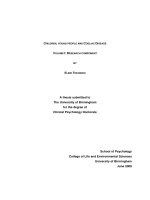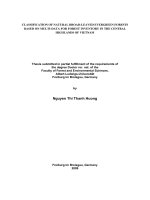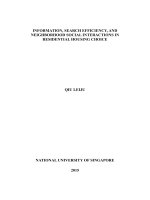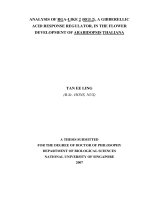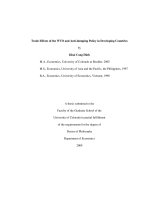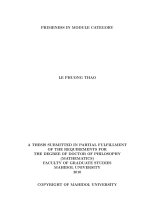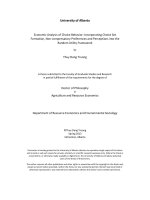Thesis Submitted For The Degree Of Doctor Of Philosophy At The University Of Leicester
Bạn đang xem bản rút gọn của tài liệu. Xem và tải ngay bản đầy đủ của tài liệu tại đây (3.15 MB, 270 trang )
FINANCIAL INSTRUMENTS DISCLOSURE: THE ROLE
OF ACCOUNTING STANDARDS
Thesis Submitted for the degree of
Doctor of Philosophy
at the University of Leicester
by
Sina Liafisu Yekini
School of Management
University of Leicester
December, 2009
1
FINANCIAL INSTRUMENTS DISCLOSURE: THE ROLE
OF ACCOUNTING STANDARDS
Abstract
A significant number of studies have pointed to inadequate disclosure of the hedging process by
companies of both details of instruments used and the clarity of information. Following the adoption
of IFRSs, UK companies started reporting under IAS 32 and 39 from the accounting year beginning
from 1st January 2005. This required more relevant information to be disclosed when compared with
the requirements of FRS 13 under which UK companies reported prior to 2005. The adoption was
consistent with reporting practices of other countries within the EU.
This study investigates the extent to which non-financial sector firms in the UK have complied with
the requirements of IAS 32 and 39 and what the value of this disclosure has been to investors. The
thesis reports on a sample of 182 firms using content analysis to evaluate reporting level in
comparison with the requirements of the standards. The thesis also uses cross sectional analysis of the
market model to assess the extent of disclosure on excess returns.
The findings show that companies reported more on derivative use under the international standards
than under UK GAAP, suggesting that harmonization of reporting practices are on course in the UK.
Secondly, companies that reported financial instruments under these standards have a lower riskadjusted discount rate. This translates to lower future returns and higher current prices, meaning
current increased market values. Further division of companies into those who disclosed at low,
medium and high levels, shows that companies that disclosed at medium and high levels have a lower
risk-adjusted discount rates. This suggests reduced risk and higher current market values for these
firms. These findings supports our earlier findings just as they support the theoretical insight that
increased disclosure means increased transparency that should positively affect firm value and vice
versa.
Sina Liafisu Yekini
2
Acknowledgements
I would like to thank the almighty God for his mercies that were available to me throughout the period
of this study. I would also like to specially thank my supervisors Dr. Geoffrey Lightfoot and Professor
Simon Lilley for their invaluable advice on critical issues. They were inspiring as well as supportive
throughout the period of this study in so many ways. My gratitude also goes to Dr. Tomasz
Wisniewski, Dr Mohammed Shaban and Dr. Muhideen Adesokan, all of whom helped me during
difficult times. They were ever willing and ready to offer suggestions, supports advice and feedback
during the period of my PhD.
My gratitude also goes to my family especially my mother, Mrs. Adiatu Yekini who is now deceased,
my wife, Kemi, and my children, Seun, Tolu, Esther, Feyi and Ore who had to endure my absence
from home in order to meet tight schedules that characterised this period. My wife’s supportive roles
and understanding are well appreciated. Lastly, I acknowledge the role played by many of my friends
too numerous to mention especially Dele Alabi, Kayode Adeniji, Segun Dosumu, Alade Salau, Mr and
Mrs Ogunsina, Dr and Mrs. Ogunsina, Dr. and Mrs. Odifa and Pastor Paul Akinwamide for the unique
ways they have helped the achievement of this lofty goal of mine.
3
Dedication
This thesis is dedicated to the Almighty God and my family
4
Contents
Abstract .................................................................................................................................................... 2
Acknowledgements .................................................................................................................................. 3
Dedication ................................................................................................................................................ 4
Abbreviations ........................................................................................................................................... 9
Chapter 1:
Introduction ...................................................................................................................... 10
1.1.
Motivation/Statement of Problem........................................................................................ 10
1.2.
Objectives of the study .......................................................................................................... 12
1.3.
The choice of Methodology ................................................................................................... 13
1.4.
Organisation of the thesis ..................................................................................................... 14
Chapter 2:
2.1
Theories, Hedging and Speculation ................................................................................. 16
Theories .................................................................................................................................. 16
2.1.1.
Introduction ....................................................................................................................... 16
2.1.2.
Agency theory .................................................................................................................... 17
2.1.2.1
Positivist Agency Theory ............................................................................................... 19
2.1.3.
Principal-Agent Research ................................................................................................. 21
2.1.4.
Positive Accounting Theory (PAT) .................................................................................. 23
2.1.5.
Regulations in firms........................................................................................................... 28
2.2
Financial risks, derivative use, hedging and speculation................................................... 32
2.2.1
Macroeconomic risks and the firm .................................................................................. 32
2.2.2
The necessity of risks in firms .......................................................................................... 33
2.2.3
The nature and use of derivatives - Empirical evidence ................................................ 37
2.2.4
Hedging and Speculation–arguments and counter-arguments ..................................... 46
Chapter 3:
Accounting Standards – Development and issues in IAS 32 and 39 ............................... 59
3.1.
Accounting Standards – History of development ............................................................... 59
3.2.
Issues in developing financial instruments standards........................................................ 62
3.3.
Financial instruments: valuation/measurement, recognition & collateral disclosures. . 66
3.4.
The issue of recognising gains through profit or equity .................................................... 68
3.5.
The theoretical issues involved in ‘fair value’ valuations. ................................................. 70
3.6.
Fair value hedge versus cash flow hedge............................................................................. 75
3.7.
Disclosure, Information and Transparency ........................................................................ 78
5
3.7.1.
Disclosure of financial Information by management in annual reports....................... 78
3.7.2.
Information asymmetry and signalling models .............................................................. 82
3.7.3.
Derivative use, disclosure and signalling ......................................................................... 85
3.7.4.
Observing the hedging process ......................................................................................... 88
3.7.5.
Derivative use and the need for disclosure ...................................................................... 91
3.7.6.
Hedging and information value ........................................................................................ 92
3.7.7.
Information asymmetry and Voluntary Disclosure ....................................................... 98
3.7.8.
Voluntary disclosure in annual reports by management ............................................. 101
3.7.9.
Derivative use reporting before and after FRS 13........................................................ 104
3.7.10.
The information gap and the need for more disclosure ........................................... 108
3.7.11.
Derivative use disclosure by non financial firms - FRS 13 vs. IFRSs ..................... 111
3.7.12.
The need for more disclosure and justification for harmonisation ......................... 116
3.7.13.
Convergence/harmonisation of derivative use disclosure and firm value .............. 119
Chapter 4:
Methodology, Data and Research design....................................................................... 122
4.1.
Introduction ......................................................................................................................... 122
4.2.
Content Analysis and extent of disclosure ........................................................................ 124
4.2.1
Empirical model A: Extent of disclosure....................................................................... 133
4.2.2
Construction of Disclosure Items and Scoring.............................................................. 136
4.2.3
Disclosed items Index Score ............................................................................................ 139
4.3.
Regulatory change and excess return ................................................................................ 140
4.4.
Empirical model B: The Event-study and its methodology ............................................ 145
4.4.1
Event-study: Application and hypothesis ...................................................................... 148
4.5.
Data Sources/Collection ...................................................................................................... 151
4.6.
The market model ............................................................................................................... 154
4.6.1.
Explanation of variables and model specification ........................................................ 161
Chapter 5:
Results and Interpretations 1: Extent of Disclosure. ...................................................... 172
5.1.
Introduction ......................................................................................................................... 172
5.2.
Qualitative disclosure.......................................................................................................... 180
5.3.
Quantitative disclosures...................................................................................................... 185
5.4.
Conclusions .......................................................................................................................... 187
Chapter 6:
Results and Interpretations II: Value Relevance of extent of disclosure ....................... 189
6
6.1
Introduction ......................................................................................................................... 189
6.2
Results and Interpretations ................................................................................................ 190
6.3
Variables and Descriptive Statistics .................................................................................. 190
6.4
OLS Cross Sectional Regression Results .......................................................................... 192
6.5
Results of our main variable .............................................................................................. 197
6.5.1
6.6
Discussion of our main variables .................................................................................... 198
Hypotheses ........................................................................................................................... 201
6.6.1
6.7.
Discussion of hypotheses ................................................................................................. 202
Diagnostic tests .................................................................................................................... 210
6.7.1
Functional Form Test (Ramsey RESET – ovtest) - Test of omitted variables ........... 210
6.7.2
Jarque-Bera (JB) test for normality in residuals .......................................................... 211
6.7.3
Test of model fit (linktest) ............................................................................................... 212
6.7.4
Test of variance inflation factor (and tolerance) .......................................................... 212
6.7.5
Hetroscedasticity .............................................................................................................. 213
Chapter 7:
Contribution and Future Research ................................................................................. 216
7.1 Chapter Overview .................................................................................................................... 216
7.2.
Empirical findings ............................................................................................................... 216
7.2.1
Overall findings from chapter five ................................................................................. 216
7.2.2.
Overall findings from chapter six .................................................................................. 220
7.3
Contributions ....................................................................................................................... 224
7.4
Limitations of the research ................................................................................................. 227
7.5
Future Research .................................................................................................................. 236
7.6
Summary .............................................................................................................................. 238
Bibliography ........................................................................................................................................ 239
Appendices ........................................................................................................................................... 258
7
List of Tables
Table 1: Classification based on size .......................................................................................... 173
Table 2: Summary of our sample companies by market capitalisation ...................................... 173
Table 3: Descriptive statistics of market type classification ....................................................... 174
Table 4: List of categories in IAS 32 and 39 and scores ............................................................ 176
Table 5: Descriptive Statistics of Qualitative and Quantitative disclosures ............................... 181
Table 6: Descriptive Statistics for Dependent and Independent Variables................................. 191
Table 7: Spearman correlation coefficients for model 1 ............................................................. 193
Table 8: Spearman correlation coefficients for model 2............................................................. 193
Table 9: OLS regression results with Excess Return as the dependent variable ........................ 194
Table 10: Classification of companies based on extent of disclosure ........................................ 204
Table 11: Functional Form Test (Ramsey RESET – ovtest) – ................................................... 210
Table 12: Test for normality of residuals .................................................................................... 211
Table 13: Test of model Fit ......................................................................................................... 212
Table 14: Variance inflation factors (VIF) for equations 6 and 7............................................... 213
Table 15: Testing for hetroscedasticity variance and ................................................................. 214
List of Appendices
Appendix 1: Summaries of International Financial reporting Standards............................................. 258
Appendix 2: CMF16015-Accounting for financial instruments IAS 32 and 39: adoption and
implementation of IAS 32 and 39 ........................................................................................................ 259
Appendix 3: October 2004: ARC endorses IAS 39 with two parts modified ...................................... 260
Appendix 4: Summaries of International Financial Reporting Standards - History of IAS 32 .......... 261
Appendix 5: Low level of disclosure suppressing the constant ........................................................... 262
Appendix 6: Our sample companies ................................................................................................... 263
Appendix 7: OLS results from equations 6 (model 1) and 7 (Model 2) .............................................. 265
Appendix 8: Statistics of Residuals; mvtest normality for excess return, disclosure level and size .. 266
Appendix 9: OLS results from equations 6 (model 3) and 7 (Model 4) .............................................. 267
Appendix 10: Our sample Companies and their market capitalisation from the London Stock Exchange
(LSE) as at 31/03/09 ............................................................................................................................ 268
8
Abbreviations
ACCA
APT
ASB
ASC
ASSC
CAPM
CIBC
CIBC
CIMA
ED
EMH
EU
FASB
FIDP
FRC
FRED
FRR
FRS
GAAP
IAS
IASB
IASC
ICAEW
IFIRC
IFRS
LSE
MSCI
NPV
OLS
PAT
SEC
SFAS
SIMEX
SSAP
WACC
Association of Chartered Certified Accountants
Arbitrage Pricing Theory
Accounting Standard Board
Accounting Standard Committee
Accounting Standards Steering Committee
Capital Asset Pricing Model
Canadian Imperial Bank of Commerce
Canadian Imperial Bank of Commerce
Chartered Institute of Management Accountants
Exposure Draft
Efficient Market Hypothesis
European Union
Financial Accounting Standards Board
Financial Instrument Discussion Paper
Financial Reporting Council
Financial reporting exposure draft
Financial Reporting Release
Financial Reporting Standards
Generally Accepted Accounting Standards
International Accounting Standards
International Accounting Standard Board
International Accounting Standard Committee
Institute of Chartered Accountants, England and Wales
International Financial Reporting Interpretations Committee
International Financial Reporting Standard
London stock Exchange
Morgan Stanley Capital International
Net Present Value
Ordinary Least Square
Positive Accounting Theory
Security and Exchange Commission
Statement of Financial Accounting Standards
Singapore International Monetary Exchange
Statement of Standard Accounting Practice
Weighted Average Cost of Capital
9
Chapter 1: Introduction
This chapter introduces the study by explaining the motivation for the study, problems to be
investigated as well as the goals and objectives. Other sections in this introductory part include a
description of the methodology chosen and a brief summary of the thesis, which highlights what to
expect in other chapters.
1.1.
Motivation/Statement of Problem
The issue of whether enough information is being disclosed in annual reports for users of financial
information, most especially investors/shareholders has been ongoing for some years in financial
reporting. The issue of derivative use in firms and whether managers are disclosing enough
information regarding derivative instruments that are being used by non-financial companies to
manage financial risks are dominant arguments in financial economics. These arguments arose
because of bankruptcies and near collapses, which are derivative-aided, that pervaded the 1990s and
2000s (Dunne and Helliar, 2002 and DaDalt et al., 2002). Examples include the Enron case on energy
derivatives as a contributing factor to its collapse, Barings Bank’s loss of £927 million speculating in
futures contract, Metallgesellschaft AG’s future hedge losses of over $1 billion (Brealey, Myers,
Marcus, 2004 p. 678-679; Hogan, 1997) and the recent hedging failure of £391 million in Mitchells
and Butlers that led to a loss of £274 million, which eroded shareholders’ value by 30% (Financial
times, 01/02/08). The loss was so monumental that it wiped out the total profit of the previous two
years. Also, substantial empirical studies have documented inadequate reporting of derivative use in
companies both in the US and the UK (Roulstone, 1999; Adedeji and Baker, 1999 and Marshall and
Weetman, 2002) under various regulatory regimes.
10
Additionally, the clamour for harmonisation of reporting practices, which calls for reporting financial
information under international accounting standards (IFRSs) as against local GAAPs, which is
expected to increase what is being reported in annual reports. UK companies started reporting under
international standards from the accounting year beginning from or after 1st of January 2005.
All of the above arguments seem to be saying that more information should be disclosed in annual
reports. From the perspective of derivative use disasters, relevant information on the hedging process
is required in order for shareholders to understand the hedging process and to make financial
statements reliable for investment decision-making. From the perspective of harmonisation, financial
statements ought to be comparable across companies and geographical divides. Consequently, this
thesis has two central motives - to evaluate the extent of information on financial instruments with
particular reference to currency derivatives used and disclosed in the first year of adoption. To do this,
we use content analysis in order to capture the extent or level of disclosure in comparison with the
requirements of relevant standards on financial instruments - IAS 32 and 39. Since the pioneering
work of Holsti (1969) on content analysis, the method has been widely used by empirical studies, such
as those of Barrett (1976), Cooke (1989) and Marston and Shrives (1991) to investigate and measure
the extent of disclosure of items of interest to them (see chapter four for a more comprehensive
discussion of the methodology). Secondly, the thesis also evaluates the effect of the level of disclosure
on a firm’s value of our sample companies using event-study methodology. This is to test the
theoretical proposition that more transparent firms should have increased firm value. Event-study
methodology is an approach popularised by the empirical works of Dolley (1933), Ball and Brown
11
(1968) and Fama et al., (1969) which is used to measure the value of a firm through the use of
financial market data (also see chapter four for a more comprehensive discussion on the methodology).
1.2.
Objectives of the study
The central objective of this study is to expand the literature on disclosure of derivative use from the
perspective of compulsory disclosure regime, which harmonization of reporting practices among
companies in the EU represents. This is the expected result from analysing what they disclosed in
respect of derivative use in their annual reports. This will consequently enable us to measure the extent
to which the objectives of IASB are being achieved. We shall also be able to make inferences as to the
level of transparency and extent of comparability of financial statements in general based on FASB
frameworks and the hedging process in particular based on the expectation of IASB.
The study also examines the impact of increased disclosure on asset pricing in these companies. This
tests the theoretical claims in the literature, which argues that increased disclosure means higher
transparency, and that this should lead to an increase in shareholders’ wealth or a firm’s value (Ball
and Brown, 1968). The study therefore examines whether there are excess returns, their impacts on the
risk-adjusted discount rates and consequently on the market value of our sample companies. This
study is an improvement on previous studies in the UK which have examined the extent of disclosure
of derivative use in annual reports of firms carried out in both pre- and post-FRS eras, which have
been dubbed the voluntary disclosure periods (Adedeji and Baker, 1999 and Marshall and Weetman,
2002). This study examines disclosures under the compulsory regime in which harmonisation is meant
to enable comparison of annual reports among companies in the European Union (EU). This is
because, for harmonisation to be meaningful, the intended benefits of comparability and improved
12
usefulness of financial statements must be achieved in accordance with FASB and IASB conceptual
frameworks (IASB, 1998 and IASB, 2005).
This study also divided the sample firms based on the level of disclosure and the effect of this level of
disclosure on a firm’s value. We did this in order to capture their effect on asset pricing and
consequently a firm’s value. The study therefore also improves on earlier studies (Roulstone, 1999
and Dunne et al., 2004) by using market data to examine the reactions of the market to disclosure of
derivative use.
In summary, the research questions are:
1. ‘To what extents have UK companies complied with the requirements of IAS 32 and 39?’
2. ‘What is the value relevance of disclosure of derivative use by UK non-financial firms under IAS
32 and 39?’
1.3.
The choice of Methodology
The research uses both content analysis and event-study methodology.
It searched annual reports of sample companies for the disclosure of the requirements of IAS 32 and
39 to obtain the extent of disclosure in order to operationalise the first method. In doing this, the
approach recommended and used by Holsti (1969), Marston and Shrives (1991), Roulstone (1999),
13
Marshall and Weetman (2002) and Lopes and Rodrigues (2005 and 2007) was adopted. (More on this
approach can be found in sections 4.2, 4.2.1……4.2.4)
Our second approach is the use of the market returns model, which is the normal return model
developed in conjunction with portfolio theory (Ball and Brown, 1968; Schwett, 1981; Dimson and
Marsh, 1986; Bens and Heltzer, 2004). Our choice of the market model is justified by the lack of size
bias, as all our sample companies are large companies quoted on the London Stock Exchange (LSE) in
FTSE 350. Dimson and Marsh (1986) suggest that non-existence of size bias is expected to produce
robust results in comparison with the constant-mean-return model. We use this model to test two
hypotheses with data obtained from our two sources – the annual reports of our sample companies and
share returns, in regressions that tested the impact of disclosure under the two standards and level of
disclosure with the inclusion of other variables (risk and performance factors) that have been tested by
prior studies. (More on this approach can be found in sections 4.3, 4.4, 4.4.1 and 4.4.2)
1.4.
Organisation of the thesis
After this introductory part of the study, there are six further chapters, organised as follows: Chapter
two presents important theories that underlie the study. In the chapter we discuss and integrate theories
such as agency theory, positive accounting theory and theories of regulation. Chapter three traces the
history of accounting standards development and discusses issues in fair value, measurement,
recognition and collateral disclosures. It also discusses relevant literatures on derivative instruments
and their uses, information disclosure and its extent in different countries. In particular, we explore
these issues in respect of the UK during and after periods of reporting under FRS 13, periods that have
14
been generally referred to as voluntary disclosure regimes. Chapter four is the presentation of the
research methodology and data gathering, where the two main methods that are later developed into
the two empirical chapters are explained. Chapters five and six are the empirical chapters, where the
results are presented and reviewed with interpretations offered. Chapter seven is where we provide our
conclusions, identify our contributions and suggest areas of future research.
15
Chapter 2: Theories, Hedging and Speculation
2.1 Theories
2.1.1.
Introduction
This study is about the use of derivatives by managers of non-financial firms in the UK, the need for
its disclosure in annual reports as well as the effect of the level of disclosure on a firm’s value. The
study starts from a review of important theories that drive disclosure of relevant and reliable
information in accounting. To this extent, agency theory and positive accounting theory, which are the
prominent theories in this thesis, will be explored. Their extension to issues of regulation, derivative
use and disclosure are also discussed.
A body of regulations has prescribed what should be disclosed at different times in history to
shareholders and investors in general. These include the Companies’ Act, Accounting Regulations and
Security and Exchange Commission (SEC) regulations in the US and the Stock Exchange Listing rules
in the UK. These regulatory regimes have largely encouraged disclosure of relevant information in the
annual reports as a way of presenting the stewardship of managers to users of accounting information
especially shareholders. The rationale for managers’ stewardship can be traced to the nature of residual
claims and the separation of management and risk-bearing in firms. The separation creates
a
principal-agency relationship that has been widely discussed in literature, with many of the studies in
this area emphasising that agency theory identifies trade-offs of risk sharing and other advantages that
should accrue to the principal and agents (Fama, 1980 and Jensen, 1983). They also use the theory to
explain the friction between the principal and the agent, which leads to agency problems arising from
the inability of the principal to verify the activities of the agent that are unobservable to the principal.
16
They argue that the consequences, which include agency costs and bonding costs, are useful in
explaining the survival of large and complex organisations.
Secondly, positive accounting theory complements agency theory as it is more specific to the issue this
thesis is investigating. The theory uses accounting in explaining the relationships between those who
provide resources to organisations. Deegan (2009: 257) refers to these parties as managers who are the
providers of labour and managerial know-how, shareholders who are the providers of equity capital
and the residual claimant and lastly the creditors. The theory also argues that when authority is
delegated, the efficiency expected in the performance of tasks will be reduced, especially when
remuneration is fixed by the contract between the parties (Watts and Zimmerman, 1978).
We use this chapter to review these two theories which helps us to lead arguments to accounting
regulations and disclosure for stewardship.
2.1.2. Agency theory
Corporations as legal entities stand on the pillar of contracts among distinct individuals in terms of
individual interests that are often diverse and conflicting (Jensen and Meckling, 1976). Much of what
happens in organisations has therefore been largely influenced by the behaviour of these distinct
individuals driven by the complex contractual systems.
Agency theory explains the contractual relationship that exists between the shareholders and managers
arising from the separation of risk bearing and the control of decision functions in firms. Like most
contractual relationships, the agency relationship requires faithfulness from both sides of the contract
17
for it to be truly enforceable. Analysis of the principal-agency relationship threw up two distinct but
complementary issues, which are behavioural in nature for resolution (Jensen, 1986). The first is the
issue of how the principal can observe the activities of the agent who performs various processes,
operations and makes decisions for the principal in organisations. The second is the issue of
conflicting goals between them with both of them having self interest far above that of the other. Since
both of them in the relationship are utility maximisers then it is argued that the agent will not act in the
best interests of the principal as to do so would minimise his self interest (Jensen and Meckling, 1976;
Fama and Jensen, 1983). The two issues discussed above led to the agency problems that call for
solutions, which in turn incur agency costs. Agency problems as argued by Jensen and Meckling
(1976) arise as a result of conflicts of interest between the parties in a contractual relationship. Agency
problems give rise to agency costs which include monitoring and bonding costs. It also includes
residual loss which arises as a result of possible decline in the welfare of the principal as a result of
differences referred to above. Jensen and Meckling (1976) argue that notwithstanding the incurrence
of the above agency costs, there will still be some divergence between the decisions made by the agent
and the expectations of the principal that would have maximised the welfare of the principal if the
difference had been eliminated or minimised. The import of this argument is that, regardless of the
incurrence of agency costs aimed at resolving the agency problems mentioned above, there are still
frictions between the principal and the agent in organisations.
Jensen and Smith (2000) analysed the conflict of interest among stockholders, managers and creditors
with particular emphasis on the principal agency relationship between stockholders and managers
from the perspective of positive theory of agency. This is why they particularly emphasised the issues
of residual claims and the separation of management and risk-bearing that characterise organisations.
18
Agency theory has developed along two approaches: the positivist agency theory popularised by
Jensen and Smith (1985 and 2000) and the principal-agent theory with Jensen and Meckling (1976)
and Jensen (1983) as proponents. Both perspectives, which we see as two sides of the same coin, are
next discussed.
2.1.2.1 Positivist Agency Theory
There are a number of sources of conflicts between managers and shareholders. One arises as a result
of management compensation contract. The conflict is basically due to differences in the lifespan of
managers and that of the organisations. Positivist agency perspective argues that the structure of
contracts limits risks undertaken by agents as a result of fixed compensation or compensation tied to
stated measures of performance. The perspective also alludes to how residual claims to net cash flows
also bring risks that are controlled with a limited liability clause to the claimants – the shareholders.
The principal’s unrestricted access to net cash flows throughout the lifespan of the organisation brings
with it the possibility of not participating in the processes in the organisation (separability). It also
brings with it rights to trade freely the residual claim which helps him to choose which risks to bear
and in organisations that offer him residual claims (tradability). The above two conditions, separability
and tradability, introduce separation of decision functions and residual risk bearing. According to
portfolio theory, the opportunity to trade freely in common stock without any restriction, which leads
to ownership of common stock in many companies, actually reduces the risks that shareholders take in
organisations. Jensen and Smith refer to this as ‘the efficiency in risk bearing’ which they argue is an
important reason why corporations survive, especially when there are large risks to be borne and
activities and processes in organisation require economies of scale (Jensen and Smith, 2000).
19
Conflicts created by this different horizon can be solved by market-based compensation plans, which
ensure that managers collect their remuneration based on the present value of the future stream of cash
flows through stock options, stock appreciation rights or other variants of aligning their interest to that
of shareholders (Brickley, Bhagat, and Lease, 1985). This way managers’ penchant for taking too little
risks is reduced as they now have incentives to increase debt, which increases the share value, his
option and consequently a firm’s value (Jensen and Smith, 2000). Studies have found the use of
market-based compensation provisions leading to stock price increases that have been associated with
anticipated productive increases, which confirm its suitability to controlling the horizon problems
(Larcker, 1983 and Brickley et al. 1985).
Another way of reducing conflict of interest is when managers’ compensation is tied to accounting
measures of performance. This gives managers incentive to use accounting methods that shift future
earnings to current periods in order for them to earn huge bonuses. Studies have shown that
compensation policies are positively related to accounting policies adopted by managers as they
examine the effect of such policies on bonuses to managers (Healy, 1985; Zmijewski and Hagerman,
1981)
A view of this model that is of interest to this study is how information systems can reduce possible
opportunism of the agents, thereby moving the agent closer to the interest of the principal. The
information effect of conflict of interest between the agent and the principal has been presented from
two perspectives. The first is the perspective of the effect of an information system on efficient capital
and labour markets as argued by Fama (1980). He argues that the perspective can reduce managers’
opportunism. He explains that when managers behave in the interests of the principal as a result of the
20
release of information hitherto known to managers, it can show in a decrease in cost of equity and
consequently cost of capital which results in an increase in a firm’s value. This is also consistent with
the conclusion of Wolfson (1985) and Barney (1988: 27) that higher level of information should be
reflected in the market through a lower cost of equity, which means a higher market value. They argue
that more information reduces managerial opportunism and co-aligns the interest of agents and
principal because the agent realises that they cannot deceive the agent.
We therefore hypothesise that the disclosure of more information by our sample firms will be reflected
in the cost of equity and consequently cost of their capital. This means that as the level of information
released increases, cost of capital will be expected to decline, which consequently mean an increase in
a firm’s value (Fama, 1980; Wolfson, 1985; Barney, 1988: 27 and Jensen and Smith, 2000). This is
also consistent with the literature that says more transparent companies should have higher market
values (Basu, 1997; Ball et al., 2003; Adam and Fernando, 2006).
2.1.3. Principal-Agent Research
This approach focuses on how optimal contracts are determined between the principal and agent as
well as the behaviour of parties in the relationship and outcome of such behaviour. A number of
models have been used to explain this approach.
One model put forward by Eisenhardt (1989) is the one that assumes goal conflict between principal
and agent, and outcomes that can be reliably measured with the agent been more risk-averse than the
principal. The agent’s risk-averse nature is a result of his inability to diversify his employment unlike
the principal who is able to diversify his risk by investing in other organisations. Two cases, one of
21
complete information and the other of inadequate information, can be used to describe the model. In
the case of complete information, no agency problem arises, but in the case of inadequate information,
given the self-interest of the agent, then he may not behave as agreed in the contract.
This leads to an agency problem, because the existence of different goals can result in what is referred
to as moral-hazard and adverse-selection problems. Moral hazards arise because the agent may be
shirking his responsibility towards the principal. The adverse-selection problem arises because the
principal may not be able to verify the claim of the agent as to experience and expertise either during
the process of hiring him or while he is working. These problems arise basically because the principal
lacks the necessary information as he cannot observe the agent’s behaviour.
Both scenarios point to a situation where one party of the contract does not have the required
information about processes and transactions that lead into output or results that he expects from the
contractual relationship. Eisenhardt (1989) suggests two ways by which the principal can gain
entrance into the information system in order to gain knowledge of relevant information in possession
of the agent. One is to provide incentives in the contract that will align agents’ interests with that of
the principal, the price of which is the transfer of risk to the agent. This makes the contract outcomebased, which is negatively related to the information system unless the outcome uncertainty is low
such that it becomes attractive to shift risks to the agent. This makes the agent behave in the interest of
the principal. The other is to invest in an information system that will reveal agents’ information
endowments or behaviour to the principal. This makes information purchased positively related to a
behaviour-based contract, which reduces both moral-hazard and adverse-selection problems. This is
done by giving support to regulations that prescribe the information to be released to the principal. In
22
the absence of moral-hazard and adverse-selection problems, the agent will also behave in the
principal’s interest and this is expected to be reflected in the value of the firm.
Conclusion
The two perspectives (positivist-agency and principal-agency) presented the theory from common
perspectives of contracting and the agency problem. They both argue the resolution of the agency
problem through the alignment of parties’ interests using information systems, the control mechanisms
especially in managers’ compensation plans, and additional costs of monitoring incurred within the
organisation, which limit the costs of separation of ownership (Fama and Jensen, 1983). From both the
principal-agent and positivist-agency angles the need for information release by the agent to the
principal is evident. The emphasis of the theory that the agent is risk-averse and self-interested, and
with the existence of information asymmetry, suggests the need for regulation that will prescribe
minimum information that managers should disclose. Before we examine regulation and disclosure,
we turn to positive accounting theory (PAT) to support our understanding of agency theory. PAT is a
fall out from the above issues in agency theory discussed above.
2.1.4. Positive Accounting Theory (PAT)
Positive theories of accounting are those theories that seek to explain and predict specific events and
their impact on organisations. PAT attempts to use the political cost hypothesis to explain why firms
make disclosures. The theory has its origin from Watts and Zimmerman’s papers (1978, 1979) and
their subsequent book titled ‘Positive Accounting Theory’ (1986). The basic assumption of the theory
is that individuals act to maximise their own utility and from managers’ point of view, because of self
23
interest, they lobby for the accounting standards that should govern their reporting practices as they
affect the value of the firm. Watts (1977) argues that positive theory helps to understand the politics
that drive accounting standard-setting process as well as the effects of accounting standards on
different users of accounting information. This is consistent with Jensen’s (1983) views that positive
theory is about the discovery of some aspects of how the world behaves, for example, on accounting
practices and how that behaviour affects the value of the firm. Positive theories therefore argue in
support of managers’ interest in those factors that affect the value of the firm. Managers’ interests in a
theory that increases a firm’s value will only increase managers’ wealth if their compensation is tied to
an accounting measure of performance which gives managers incentives to use accounting methods
that shift future earnings to the current period, so that they can earn substantial bonuses. Their wealth
can also increase if share prices increase but their compensation plan will also have to be tied to such
increases through stock options or appreciation rights. Watts and Zimmerman (1978) argued that
managers with compensation plans tied to a stated measure of performance have an incentive to lobby
for, and report under, accounting standards that report current higher cash flows that enhances their
wealth while also increasing shareholders’ wealth.
A number of studies have documented the strong pressure on standards setters from firms whose
activities are to be regulated by accounting standards (Zeff, 1972 and Horngren, 1976). This immense
pressure eventually determines which accounting standards see the light of day, which explains
managers’ eventual compliance or extent of compliance with the requirements of the standards.
Belkaoui and Karpik (1989) and Lemon and Cahan (1997) also provide evidence that corporate
lobbying precedes financial accounting standards setting in as much as the standards are likely to
24
affect future cash flows and earnings of the firm. Their evidence supports the political cost hypothesis
of Watts and Zimmerman (1978, 1979).
Positive accounting theory is essentially about social disclosures in annual reports and factors that
determine the level of disclosure. This was largely found in the argument of Watts and Zimmerman
and other writers who attempted to test this argument. Notable among those who attempted to test their
argument so closely are Belkaoui and Karpik (1989). Belkaoui and Karpik (1989) follow their
argument in their investigation of determinants of social disclosures by using debt/equity measures of
social and economic performance in addition to political costs hypothesis used by Watts and
Zimmerman. They found size, beta (risk) and leverage significant in the model. This means that the
above variables are partly able to explain social disclosures. Both size and beta are the proxies used for
political costs, which are central to Watts and Zimmerman’s argument. This further means that
Belkaoui and Karpik concur with Watts and Zimmerman’s argument. This may be because the large
firms used in Watts and Zimmerman’s paper are largely oil companies, and seven out of 33 companies
used by Belkaoui and Karpik (1989) are also from the oil industry. The industry is known to contain
large companies usually with large profits and also with political vulnerability arising from associated
problems with the industry. The problems include environmental degradation and depletion of
resources as well as exploitation of workers that often characterise oil companies. Although Belkaoui
and Karpik (1989) uphold Watts and Zimmerman’s argument that levels of social spending and/or
disclosure by managers are ways of reducing current income, they failed to test the proposition. Both
Reiter (1998) and Milne (2002) also criticised studies on social disclosure for failing to establish the
wider basis for their findings, as they only used accounting method choices which are consistent with
the aim of positive accounting theory. The aim of PAT is to present evidence of self-interested
25
